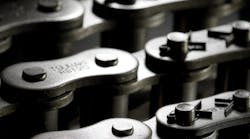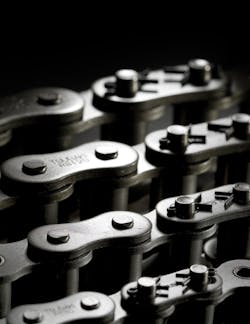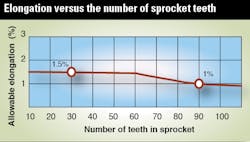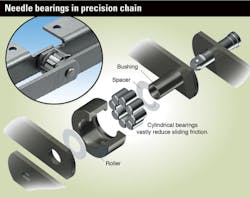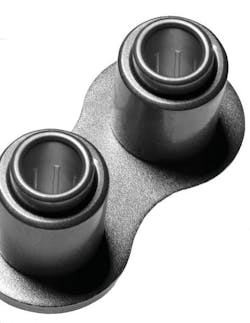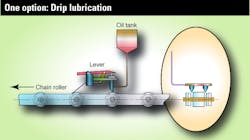Getting more life from roller chain
Despite high hardness due to heat treatment, roller chain consists of several moving components that eventually wear, especially in demanding applications.
Let's explore the mechanics of wear and the options to maximize chain life.
Wear occurs on chain in three primary ways:
• Articulation of the pin against the bushing when the chain enters and exits a sprocket
• Rotation of the rollers against the bushing when engaging a sprocket
• On the side plates if there is rubbing or sliding on a guide.
The area between the pin and bushing is both the most critical and the most difficult area to lubricate because it is internal to the chain; this is the area responsible for wear elongation.
Through normal operation, chain eventually elongates due to wear between the pin and bushing. Some refer to the increase in length as stretch. However, when properly loaded, it is due to wear, not actual deformation of components.
For drive applications with fewer than 60 teeth on the sprocket, replacement of the chain is suggested when it reaches 1.5% elongation, measured over at least six pitches; however, a longer length of chain allows an even better assessment. (For conveyor applications, chains can be used up to 2% elongation.)
Chains can operate with up to 3% elongation, but this may result in sprocket damage, chain-jumping sprocket teeth, unexpected loading, or increased vibration and noise.
Chains used beyond the suggested amount of wear lose fatigue strength due to material being worn from the pin.
Note: Regardless of average chain elongation, if any single pin-bushing joint experiences excessive wear, it may be necessary to replace the chain.
Fundamentals of lubrication
Lubrication acts to form a slippery film on the chain components, helping to minimize direct metal-to-metal contact, thereby reducing wear and friction. The covering of lubrication also acts to create a barrier against moisture that helps the metal components resist corrosion.
An additional benefit is a reduction of noise, as the lube buffers the impact when the roller engages the sprocket.
Some manufacturers prelubricate standard drive chains using a hot-soak process. Here, chains are submerged in a heated lubricant bath to ensure that all components are coated, even deep into the pin-bushing joint. This gives the chains maximum possible life for applications in which chains are not relubricated.
For those situations in which chains are lubricated, prelubrication ensures maximum protection during the run-in period.
Lube-free chains
Where lubrication is not feasible or desirable in slow to medium-speed applications, self-lubricating chains exist. Certain chains incorporate a hardened, oil-impregnated, self lubricating bushing that provides lubrication where it is needed most — at the critical pin-bushing joint and between the bushing and roller. The pins are nickel-plated and the plates are black-oxide coated for extra protection.
Self-lubricating chains stay cleaner because the exterior is free of excess lube, and attracts less dust and particulates than regular chain. This is essential in areas where oil contamination may be a concern, such as the paper products or wood processing industries.
These chains are available in both conveyor and drive series.
Drive series has heavy, extra-thick roller link plates to provide extra strength and bearing area, and has the same load capacity as standard drive chain. The conveyor series has standard ASME (ANSI) B29.1 dimensions.
Sealed roller chains
Sealed chains are useful in applications with especially high levels of abrasives or particulates that could otherwise accumulate inside the chain. Dimensionally, this class of chains is wider than standard to accommodate the seal between the plates.
Traditional O-ring chain is designed with a rubber seal compressed between the pin link and roller link plates to hold lubrication between the pin and bushing and keep contaminants out; however, it is not considered a lube-free chain. Lubrication is still required for the roller and to keep the O ring from drying out.
Once the lubrication within the pin-bushing joint is consumed, additional lubrication is prevented from entering because of the O ring. Because the O rings are under compression between the plates, the resultant friction leads to a greater force requirement to articulate the chain, decreasing the transmitted power. At places where chain tension is low (such as the return side), the strand may not fully straighten without an added tensioner.
Some chain varieties offer the benefits of lube-free operation plus a felt seal between the pin link and roller link plates. The bushing is extended to help keep the felt from compressing. The self-lubricating bushing is in contact with the roller and bushing to control wear, plus the felt helps to keep contaminants from entering the roller-bushing area. Unlike regular O-ring chain, this kind of chain is both sealed and lube free, and allows free flexing.
Specialty bearing conveyor chains are also available in a variety of sizes. They feature special needle bearings between the pins and bushings, which virtually eliminates wear elongation, making it suitable for indexing in the most precise applications.
For example, in an application that automatically installs electronic parts at 30 stations, a conveying speed of 10 m/min., and an index of 0.6 seconds, the positioning accuracy is held to ±0.2 mm using a positioning pin.
This chain stretches little (less than 0.03%) during the initial run-in period — and then experiences virtually no change in length for the rest of the chain's working life. This eliminates position and take-up adjustment — and lubrication maintenance.
Oil type and temperature
The proper lubricant depends on the application. Overall, clean high-quality, non-detergent, petroleum-based or synthetic oil is best. Lube that is too viscous (such as grease) cannot penetrate the critical pin-bushing joint. Properly lubricated chains also minimize corrosion due to exposure, and maximize chain life by avoiding direct metal-to-metal contact.
At very low temperatures, a lubricant increases in viscosity. Even in these situations, correctly selected lubricants flow into the critical pin-bushing contact area, minimizing chain wear.
At particularly high temperatures, specialty lube must be selected. Regular lubricants may dissipate, carbonize (burn off), or deteriorate more quickly, leaving oil residues and buildup which may interfere with chain flexing. Binding may occur in extreme cases.
Note: For temperatures below 14°F or above 140°F, contact a lubrication specialist.
The overall requirement is that oil is applied using a method that gets an adequate amount into the pin-bushing joint of the chain. There are three general lubrication strategies that are directly related to the speed and horsepower transferred through a chain.
Lubrication is best applied to the clearance between the link plates on the slack side of the chain, where it has the lowest tension. The fastest and most highly loaded chains require more sophisticated lubrication systems. Note that while lubrication greatly reduces wear, it does not eliminate it completely.
The chain manufacturer's catalog should be consulted to determine the suggested lubricant system. In some catalogs, these include: A — Manual or drip; B — oil bath, in which the chain dips through a contained pool; or for the fastest chains, C — pump-applied forced lubrication.
For all lubrication methods, operators must regularly inspect the system to ensure proper operation.
Automatic lubrication saves labor and keeps even remotely located chains oiled. Regular checks of oil levels, flow, and proper aim are necessary to ensure that the oil is being applied where it is needed.
A. Manual and “drip” lubrication are the most basic methods and are appropriate for slow speeds. Manual lubrication requires periodic monitoring to ensure the chains remain coated with lube and do not dry out.
Drip lubricators allow a slow but steady flow of lubrication onto the chain. Drip lubricators can be accessorized with a brush applicator or a air-assisted mist-type lubricator, which are useful in applications such as overhead trolley conveyors or when the chain has many points requiring lubrication.
B. Chains in medium-speed applications are good candidates for lubrication baths or slinger discs because centrifugal forces tend to fling lubrication from chain joints. For bath lubrication, operators must inspect the oil level and check that there is no sludge. The system should be drained, flushed, and refilled when the application requires it. In addition, the chain should be submerged 1/4 to 1/2-in. deep. If it is too deep, then the oil may heat up too much and be adversely affected. Properly installed slinger discs act to splash lubrication onto the chain in key areas for more complete coverage.
C. For the highest speeds, high-pressure forced lubrication is necessary to get enough lubrication to the critical pin-bushing joint to prevent galling. It also helps to keep the temperature of the chain down. The oil temperature should be monitored and a cooling system may be necessary to keep the lube from overheating and degrading.
Other chain-saving considerations
Other factors affect chain wear rate, including those related to the components and assembly.
The surface condition (roughness) and roundness of the pins and bushings certainly influence wear rate: Therefore, some manufacturers grind the pins after hardening to ensure a smooth finish. Bushings are typically formed with specialized processes that achieve nearly perfect roundness, and a precision-controlled surface condition.
Even the assembly process is critical: The pins in each link must be parallel for optimum load distribution to avoid pressure points where accelerated wear could initiate. Pre-stressing chain helps to nearly eliminate initial run-in elongation.
Troubleshooting roller-chain installations
Additional setup and environmental factors must be considered when optimizing a chain system. Some of these include:
Corrosion-enhanced wear: A film of lubrication helps chain avoid rust by protecting it from moisture. When exposed to wet or other mildly corrosive environments, specialty chain coated with layers of corrosion-resisting elements can be utilized to defend against rust and premature elongation.
Sprocket Alignment: If sprockets are angled relative to each other or not on the same plane, extra forces on the chain may increase wear rate considerably.
Over-tensioning: Tightening a chain more than necessary in an application directly affects the rate of wear. In a typical drive application, there is slack on the return side.
Incorrect chain size: An improperly selected chain size will not have the capacity to transfer the target load, resulting in accelerated wear. Please verify chain selection in manufacturer catalogs.
__________________________________________
This article is a primer. For detailed engineering guidance on a specific application, call (800) 323-7794. Otherwise, refer to U.S. Tsubaki Catalog L10940 and The Complete Guide to Chain in print or online at chain-guide.com.
